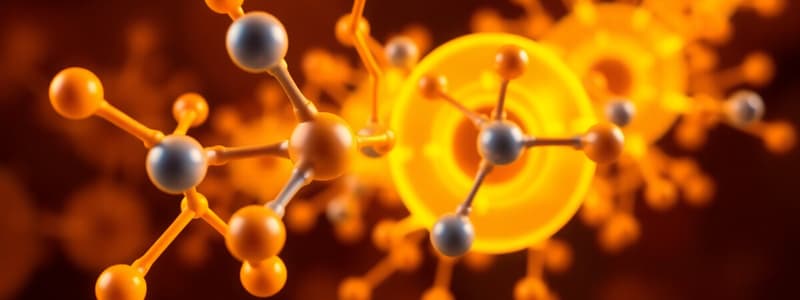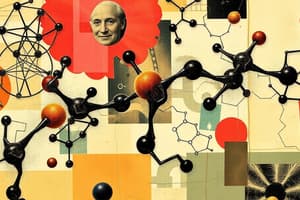Podcast
Questions and Answers
What is a primary benefit of in vitro tests in research programs?
What is a primary benefit of in vitro tests in research programs?
- Identification of effective prodrugs
- Determination of drug potency
- Demonstration of physiological or clinical effects
- Not requiring animal or human testing (correct)
Which of the following statements about high-throughput screening (HTS) is true?
Which of the following statements about high-throughput screening (HTS) is true?
- HTS is more costly compared to traditional screening methods.
- HTS can test biochemical or biological assays in micro-scale wells. (correct)
- HTS measures physiological effects in live subjects.
- HTS requires large sample volumes for accurate results.
Which characteristic defines a lead compound in drug development?
Which characteristic defines a lead compound in drug development?
- It must demonstrate a property likely to be therapeutically useful. (correct)
- It is always a synthetic compound.
- It has already undergone clinical trials.
- It is derived exclusively from animal testing.
What is a significant limitation of in vivo testing?
What is a significant limitation of in vivo testing?
In the context of drug design, what is meant by drug potency?
In the context of drug design, what is meant by drug potency?
What is the primary focus of target-based drug design?
What is the primary focus of target-based drug design?
Which method provides dynamic structural information about a target but is limited in size?
Which method provides dynamic structural information about a target but is limited in size?
Which types of interactions are considered favorable for ligand-target binding?
Which types of interactions are considered favorable for ligand-target binding?
What is a key advantage of using computational chemistry in drug design?
What is a key advantage of using computational chemistry in drug design?
What is a characteristic of the binding pocket in target-based drug design?
What is a characteristic of the binding pocket in target-based drug design?
Which structural determination method is capable of providing atomic level structural information?
Which structural determination method is capable of providing atomic level structural information?
In rational drug design, what role does examining the structure of active small molecules play?
In rational drug design, what role does examining the structure of active small molecules play?
What is a limitation of X-ray Crystallography compared to NMR spectroscopy in the context of structural determination?
What is a limitation of X-ray Crystallography compared to NMR spectroscopy in the context of structural determination?
What is the primary goal of combinatorial chemistry in drug design?
What is the primary goal of combinatorial chemistry in drug design?
Which of the following antibiotic classes is known for their beta-lactam structure?
Which of the following antibiotic classes is known for their beta-lactam structure?
Which technique is primarily used in structural determination of drug compounds?
Which technique is primarily used in structural determination of drug compounds?
What is the significance of ligand-target interactions in drug design?
What is the significance of ligand-target interactions in drug design?
In computational chemistry for drug design, which of the following methods is utilized for predicting molecular behavior?
In computational chemistry for drug design, which of the following methods is utilized for predicting molecular behavior?
Which type of drug design is focused on a target's biological pathway?
Which type of drug design is focused on a target's biological pathway?
Which structure-function relationship is key for the effectiveness of tetracyclines?
Which structure-function relationship is key for the effectiveness of tetracyclines?
Which of the following best describes the role of automated methods in rational drug design?
Which of the following best describes the role of automated methods in rational drug design?
What characteristic is primarily associated with chloramphenicol's mode of action?
What characteristic is primarily associated with chloramphenicol's mode of action?
Which component is NOT typically involved in ligand-target interactions?
Which component is NOT typically involved in ligand-target interactions?
What does the pharmacophore-based drug design primarily identify?
What does the pharmacophore-based drug design primarily identify?
How is the active conformation of a drug typically determined?
How is the active conformation of a drug typically determined?
Which of the following accurately describes a key role of histamine in drug design related to H2 antagonists?
Which of the following accurately describes a key role of histamine in drug design related to H2 antagonists?
What structural feature is essential for 2D representation in pharmacophore modeling?
What structural feature is essential for 2D representation in pharmacophore modeling?
What is the primary goal of lead optimization in drug discovery?
What is the primary goal of lead optimization in drug discovery?
What was the significance of Cimetidine in pharmacology?
What was the significance of Cimetidine in pharmacology?
In the context of drug discovery, what is the significance of chemical similarity during lead generation?
In the context of drug discovery, what is the significance of chemical similarity during lead generation?
Which aspect of ligand-target interactions is highlighted in the pharmacophore approach?
Which aspect of ligand-target interactions is highlighted in the pharmacophore approach?
Which of the following processes is crucial for the initial identification of new drug candidates?
Which of the following processes is crucial for the initial identification of new drug candidates?
In target-based drug design, which of the following methods often aids in structural determination?
In target-based drug design, which of the following methods often aids in structural determination?
Which type of drug action is primarily associated with DNA intercalating agents?
Which type of drug action is primarily associated with DNA intercalating agents?
During the drug design process, what is the primary goal of computational chemistry?
During the drug design process, what is the primary goal of computational chemistry?
What is the first step in the drug discovery process according to the described methodology?
What is the first step in the drug discovery process according to the described methodology?
What does the term 'minimum skeleton' refer to in pharmacophore-based drug design?
What does the term 'minimum skeleton' refer to in pharmacophore-based drug design?
What is the role of agonists in the context of G-Protein Coupled Receptors?
What is the role of agonists in the context of G-Protein Coupled Receptors?
Which of the following statements accurately describes reversible enzyme inhibitors?
Which of the following statements accurately describes reversible enzyme inhibitors?
What is the expected duration of preclinical testing in the drug discovery pipeline?
What is the expected duration of preclinical testing in the drug discovery pipeline?
Which of the following is a method used for structural determination in drug design?
Which of the following is a method used for structural determination in drug design?
What is the purpose of establishing testing procedures (bioassay) in the drug discovery process?
What is the purpose of establishing testing procedures (bioassay) in the drug discovery process?
Flashcards are hidden until you start studying
Study Notes
Lead Compound & Drug Design
- The process of designing new molecules to optimally interact with a target and block or trigger a specific biological activity of the target.
- The goal is to design compounds that satisfy specific requirements obtained from target-based and pharmacophore-based drug design.
Target-based (Receptor-based) Drug Design
- Examine the 3D structure of the biological target, preferably with a bound small molecule ligand.
- Identify and characterize the binding pocket, including its shape, charges, hydrophobic surfaces, and groups with hydrogen bond-forming ability.
- Use computational chemistry to model structures of the small molecule bound to the active site of the target.
- Examine the docking structures for chemical groups on the target that could contribute favorably to its interaction with the compound, including electrostatic interactions, hydrogen bonds, hydrophobic complementarity, and geometrical fit of the surfaces.
- Design a drug candidate that will have multiple sites of favorable interactions with the biological target.
Pharmacophore
- Defines the important groups involved in binding and activity.
- Defines the relative positions of the binding groups in 2D and 3D.
- Need to determine the active conformation.
Lead Compound
- A compound demonstrating a property likely to be therapeutically useful.
- Used as the starting point for drug design and development.
- Found by screening compounds (natural or synthetic) or by rational design (molecular modeling).
Drug Discovery & Development
- Pharmaceutical companies are in the business of identifying compounds that may be useful new drugs.
- This process involves:
- Identifying the target disease and drug target
- Establishing testing procedures (bioassay).
- Testing in two stages: Lead Generation (find a compound that binds) and Lead Optimization (find a compound that binds better).
Bioassay
- Bioassays are required to find lead compounds and optimize drugs.
- Bioassays can be carried out in vitro and in vivo.
Drug Targets and Mechanisms of Drug Action
- Enzymes – inhibitors (reversible, irreversible)
- G-Protein Coupled Receptors – agonists and antagonists
- Ion Channels – blockers
- Transporters – uptake inhibitors
- DNA – intercalating agents
In Vitro Tests
- Targets (e.g. isolated enzymes or receptors): Cells (e.g. cloned cells), Tissues (e.g. muscle tissue); Organs; Micro-organisms (for antibacterial agents).
- Measure the interaction but not the ability of the drug to reach the target.
- Tests not carried out on animals/humans.
- Used in high-throughput screening.
In Vivo Tests
- Carried out on live animals or humans.
- Measure an observed physiological effect.
- Measure a drug’s ability to interact with its target and its ability to reach that target.
- Can identify possible side effects.
High Throughput Screening (HTS)
- Plates: 384, 1536, or 3456 wells.
- Sample scale: as small as nano- or pico-liter per well.
- Types of assays: biochemical or biological.
- Detection: fluorescence, luminescence, scattering, radioactivity.
- Cost-effectiveness and speed of compound scanning.
Combinatorial Chemistry Approach
- Automated approach to synthesizing mixtures of many different structures in a short time.
- Produce a pool of chemicals which may prove to include a useful lead compound.
Simplified Major Steps in DDD/Medicinal Chemistry
- Discovery (finding lead compounds).
- Optimization (Structure-Activity Relationships).
- Development (Chemical formulation for suitable clinical use).
Studying That Suits You
Use AI to generate personalized quizzes and flashcards to suit your learning preferences.




